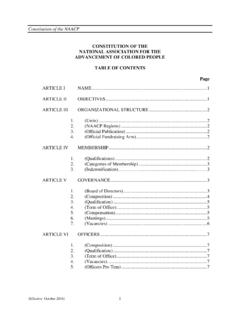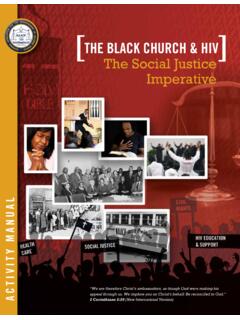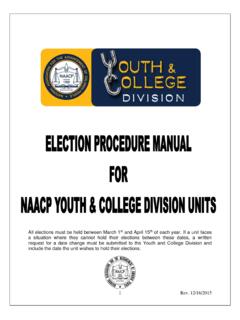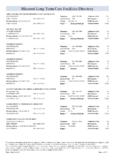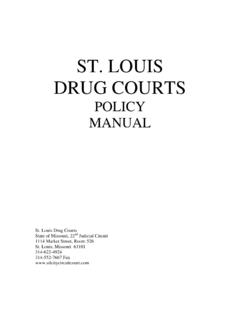Transcription of ST. LOUIS - NAACP
1 ST. LOUIS METROPOLITAN AREA | ECONOMIC INCLUSION PLAN | VOLUME 1ST. LOUISLeon W. RussellChairman, Board of DirectorsDerrick JohnsonPresident & CEOPAGE 2 | NAACPDear Community Members and Stakeholders: When I joined the NAACP , I envisioned an Economic Department that would promote evidence-based approaches to improve the economic conditions of African American communities in cities across the nation. From that vision, came an opportunity to partner with Wells Fargo to develop Economic Inclusion Plans for communities of color that would address racial and economic disparities in affordable housing, minority homeownership, minority entrepreneurship, employ-ment, and educational attainment. The NAACP understands that economic disparity is a contributing factor to social and political turmoil and, as a result, renews its commitment to support economic inclusion in the communities we serve through advocacy, and direct service.
2 Through the Wells Fargo partnership, NAACP advances its goal of increasing financial and economic efficacy for citizens across the United States. The NAACP Economic Department will continue to monitor the national socio-economic disparities and the widening gaps in wealth and income. With continued research, policy analysis, and program development, greater access and opportunities can be achieved for communities of color which will ultimately help in creating a more equal nation. Sincerely,Marvin Owens, Jr. Sr. Director, Economic Programs National Association for the Advancement of Colored PeopleMESSAGE FROM MARVIN OWENS 3 | NAACPTABLE OF CONTENTSL etter from Marvin .. 2 Executive 4 St. LOUIS Plan .. 6 Housing .. 8 Education .. 10 Employment .. 12 Small Business .. 14 Criminal Justice.
3 16 Housing .. 18 Education Policy Prescription .. 20 Employment Policy Prescription .. 24 Additional Opportunities .. 28 Final Call to Action .. 30 References .. 31 Thanks .. 32 PAGE 4 | NAACPEXECUTIVE SUMMARYF ifty years ago, an appeal for a national role in curing economic ailments was made by Dr. Martin Luther King at a Senate hearing on the Federal Role in Urban Affairs. At the hearing, Dr. Martin Luther King, Jr. called for a rebalancing of the nation s priorities and stated: The sorry record of income, public service, and education, indicates that we are not doing enough. A major reason for our failures is that we aim too low. Our goal is not to bring the discriminated up to a limited, particular level, but to reduce the gap between them and the rest of American society. iThirty years ago, the call to action was renewed by Thurgood Marshall, former Justice of the United States Supreme Court when he stated: We must dissent from a nation that has buried its head in the sand, waiting in vain for the needs of its poor, its elderly, and its sick to disappear and just blow away We must dissent from a government that has left its young without jobs, education or hope.
4 We must dissent from the poverty of vision and the absence of moral leadership. We must dissent because America can do better, because America has no choice but to do better. iiKing and Marshall, two of America s most profound justice warriors, recognized the need to address the nation s worst economic conditions in order to improve the greater economy and general welfare of the United States of , given the current economic reality in the United States, past leaders join present populations confined to the lower peripheral edges of American society in having their calls for action go unheard. In recent years, those groups have continued to speak out in a frequently dejected yet distinctly familiar language. PAGE 5 | NAACP Riot is the language of the unheard, said Dr. King when speaking on the social unrests taking place across the nation during the American Civil Rights movement.
5 Iii Indeed, unrests in the form of riots in peaceful protests have reemerged in recent years in response to the abhorrent police-involved shootings of adults and youth of color in communities already plagued by economic atrocities. No exception to the trend are cities like Baltimore, Charlotte, and St. LOUIS where recent shootings of African Americans by local law enforcement have forced thousands to pour into the streets in desperate attempts to be heard. The Economic Inclusion Plan seeks to amplify the voices of economically deprived communities by highlighting persistent and well-documented historical racial and ethnic economic disparities in cities dealing with recent social unrest. The Report uses research, data gathering, data analysis, and interviews with community members to unearth the current economic conditions which exist beneath the issues of police distrust and continue to fuel community frustration.
6 In particular, the Report assesses the historical and present economic concerns of black commu-nities in affordable housing, homeownership, business development, unemployment, and education graduation findings of the report reveal sharp similarities between the past economic realities of African Americans during reconstruction and legal-ized racism and the current economic realities more than 150 years after the abolishment of slavery and promise of freedom. With African Americans still living in highly segregated communities and school districts, comprising the lowest median household income, highest unemployment rate, highest poverty rate, and ongoing barriers to the creation of small businesses, the promise of freedom has been averted by racial discrimination. To address these challenges, NAACP develops a comprehensive, data-based, economic agenda that both responds to flashpoints of economic injustice and promotes policy and programmatic solutions to addressing the pressing needs in unheard communities across the nation.
7 It is critically important for all people, especially those invested in local, state, and national economic growth, to address the conditions of these communities, the failure of which has the potential to mark continued unrest. Early resistance to the African American migration to the St. LOUIS metropolitan area set the stage for the continued community isolation marked with high rates of poverty and limited economic opportunity. By 1917, African Americans were arriving to the area in large numbers seeking industrial jobs with better wages and work conditions than those found in the share-cropping south. The metropolitan area cities The Troubled Relationship Between Poverty and Unrest in St. LOUIS , MissouriPAGE 7 | NAACPin the north held the promise of economic oppor-tunity, security, and community building.
8 However, the influx of new workers was perceived by existing labor groups as an economic threat and was met with violence. A documented 3,000 white men, led by job insecurity, flooded the streets of downtown East St. LOUIS , (a city located in Illinois and across the Mississippi river from St. LOUIS city) and began attacking African Americans. The violent attack became known as the East St. LOUIS riots and is regarded as one of the worst race-riots in history resulting in what the NAACP estimated at the time to be nearly 200 African Americans dead and 6,000 African Americans homeless after their homes were burned. ivThough, most interesting is the fact that, unlike the neighboring city of East St. LOUIS , the city of St. LOUIS had not experienced race-related riots. Because of this, the unrest after the killing of Michael Brown may have come as a surprise to come, but with a close tracking of the racialized politics in the city and surrounding counties, it becomes clear that community frustration was years in the making and the unjust killing of one member of the community is an affront to the entire race whose lives had been attacked through covert and overt racism for , specific and targeted laws and policies have been implemented to disenfranchise and deny African American entry into the economic mainstream, including police and judicial targeting of poor black communities with onerous fines and jail time for often petty offenses that encourage perpetual poverty.
9 The statistics are dramatic and provide proof that the past public policy objective of isolating, criminalizing, and disenfranchising St. LOUIS s African American community was a resounding , racial tensions and unrest persist in the St. LOUIS metropolitan area as black residents continue to lack equal access to the American dream. The concept of the American dream is rooted in the Decla-ration of Independence and embodies ideals that all men are created equal and everyone, regardless of social class, should have the opportunity to achieve. However, in 2014, when unarmed 18-year old Michael Brown was shot and killed by law enforcement in Ferguson, Missouri, people of all races across the world began to protest a prevailing disregard for black lives. As of October 2017, protests broke out daily following the acquittal of a law enforcement officer who killed 24-year-old Anthony Lamar Smith.
10 Brown and Smith lost their lives during police encounters but to fully understand the demonstrations behind these encounters, the historical and present-day perspectives of how black lives are impacted by government-sanctioned policies are critical. In order to move past these social and human ailments, public policy must discover ways to unwind the cruel and vindictive policies of the past and find effective ways to enfranchise the African American population of St. LOUIS city and surrounding counties, and allow prosperity of isolated communities to be the catalyst for economic growth for the entire city. The Troubled Relationship Between Poverty and Unrest in St. LOUIS , MissouriWith a dissimilarity index above 70, the St. LOUIS MSA has an extremely high level of black-white segregation. Segregation INDEX (2010) PAGE 8 | NAACPG overnment sanctioned policies and practices that disparately impacted black homeownership have created long-lasting economic implications for black families.

